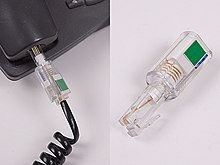Helical telephone cord

A spiral telephone cord , also known colloquially as a spiral telephone cord , is the connection between the receiver and the base unit of a telephone by means of a spiral cable.
At the beginning of the 1960s , this form replaced the previously smooth, mostly fabric-spun cords. The advantage of this shape is that the cord is quite short when relaxed, but it expands when pulled. This is achieved by fine for the current-carrying conductor stranded conductor , usually Tinsel be used.
With the spread of cordless telephones since the 1990s, spiral telephone cords are becoming less important.
While the handset cord was initially firmly connected to the handset and the device, from around 1982 the use of modular plugs of the type 4P4C on both sides , colloquially called RJ-10, became popular, making defective cords easy to replace by the user.
A well-known everyday phenomenon is the "tangled" telephone cord: the turns of the helix hook into another point of the helical cord - up to the point of tangling. This phenomenon is caused by repeated rotation of the listener around its longitudinal axis. This cannot absorb the cord, which is fixed in its spiral shape, by compressing the spiral - a loop in the entire structure or kinking occurs . Twist and twist protection in the form of an electromechanical slip ring system with an RJ plug connection , which compensates for the twisting of the cable, are available from specialist retailers . The contact is made via an arrangement of sliding contacts and rings.
Individual evidence
- ↑ Handbook of Telecommunications, Fundamentals of Telecommunications, Book Series BFt, Volume G (as of 1970), Section on Telephone 61
